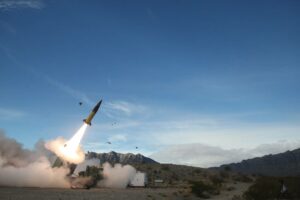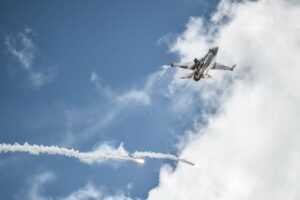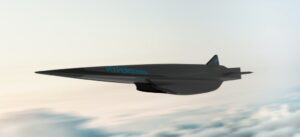
Editor’s note: This story has been updated to include information from a Pentagon spokesperson.
WASHINGTON — The Pentagon committed on Monday to fielding thousands of attritable, autonomous systems across multiple domains within the next two years as part of a new initiative to better compete with China.
The program, dubbed Replicator, was announced by Deputy Defense Secretary Kathleen Hicks, speaking at the National Defense Industrial Association’s Emerging Technologies conference here.
“Replicator will galvanize progress in the too-slow shift of U.S. military innovation to leverage platforms that are small, smart, cheap and many,” Hicks said.
Hicks and Vice Chairman of the Joint Chiefs of Staff Adm. Christopher Grady will oversee the program, with support from Doug Beck, director of the Defense Innovation Unit. Further details, Hicks said, will be released in the coming weeks.
Replicator rests on two assumptions. The first is that China’s core advantage is mass — “more ships, more missiles, more people,” as Hicks said — and that the United States’ best response is to innovate, rather than match that pound for pound.
The second is that attritable, autonomous systems are the right form of innovation. Hicks pointed to the war in Ukraine, in which cheap, often commercial drones have proven indispensable on the battlefield for reconaissance, targeting, and attacks. Russia too, she said, appeared to have a similar mass before launching its invasion last February.
However, this program is squarely focused on China. Hicks called this moment a “generational challenge to American society.”
”We’ll counter the [People’s Liberation Army’s] mass with mass of our own, but ours will be harder to plan for, harder to hit, and harder to beat,” she said.
Even so, Hicks noted the Pentagon will remain focused on its core systems. “America still benefits from platforms that are large, exquisite, expensive, and few,” she said. Instead, she said, Replicator is particularly focused on accelerating DoD’s recent investments in autonomous systems.
Replicator’s goal of fielding small drones in high numbers and on a rapid timeline echoes calls from former DIU director Mike Brown for the Pentagon to better leverage commercial innovation to deliver capability at scale — an approach he called a “hedge strategy.”
House appropriators have backed that idea in their fiscal 2025 defense spending bill. The legislation would allocate $1 billion toward establishing a DIU-managed hedge portfolio made up of low-cost drones, agile communication and computing modes and AI capabilities.
The Department of Defense requested $1.8 billion for artificial intelligence for fiscal 2024 and was overseeing more than 685 related projects as of 2021. Replicator is intended to pull those investments together and further scale production, Hicks said.
“It’s a reorganization of largely existing funds, and expected to cost in the range of the hundreds of millions,” wrote Eric Pahon, a spokesman for Hicks, in an email.
This is far from the first Defense Department innovation program, and Hicks invoked several past ones near the top of her speech. Such initiatives, in the past, were referenced so often they nearly became buzzwords.
Hicks is betting against that outcome today. “We know we can do it,” she said. “It doesn’t mean it’s without risk. We’ve got to take a big bet here.”
Noah Robertson is the Pentagon reporter at Defense News. He previously covered national security for the Christian Science Monitor. He holds a bachelor’s degree in English and government from the College of William & Mary in his hometown of Williamsburg, Virginia.
- SEO Powered Content & PR Distribution. Get Amplified Today.
- PlatoData.Network Vertical Generative Ai. Empower Yourself. Access Here.
- PlatoAiStream. Web3 Intelligence. Knowledge Amplified. Access Here.
- PlatoESG. Automotive / EVs, Carbon, CleanTech, Energy, Environment, Solar, Waste Management. Access Here.
- PlatoHealth. Biotech and Clinical Trials Intelligence. Access Here.
- ChartPrime. Elevate your Trading Game with ChartPrime. Access Here.
- BlockOffsets. Modernizing Environmental Offset Ownership. Access Here.
- Source: https://www.defensenews.com/pentagon/2023/08/28/pentagon-unveils-replicator-drone-program-to-compete-with-china/
- :has
- :is
- $1 billion
- $UP
- 2021
- 2024
- 2025
- 70
- 8
- 9
- a
- accelerating
- across
- ADvantage
- against
- agile
- AI
- allocate
- American
- an
- and
- announced
- appeared
- approach
- ARE
- artificial
- artificial intelligence
- AS
- assumptions
- At
- Attacks
- autonomous
- autonomous systems
- backed
- Battlefield
- BE
- became
- been
- before
- benefits
- BEST
- Bet
- Better
- Betting
- Big
- Bill
- Billion
- brown
- but
- by
- called
- Calls
- CAN
- capabilities
- capability
- chairman
- challenge
- cheap
- China
- Chinas
- Christopher
- College
- coming
- coming weeks
- commercial
- committed
- Communication
- compete
- computing
- Conference
- Core
- Cost
- Counter
- covered
- Defense
- Defense Department
- Degree
- deliver
- Department
- department of defense
- deputy
- details
- Director
- do
- Doesn’t
- domains
- doug
- drone
- Drones
- dubbed
- echoes
- emerging
- emerging technologies
- English
- establishing
- Ether (ETH)
- existing
- expected
- expensive
- exquisite
- far
- February
- few
- First
- Fiscal
- focused
- For
- form
- Former
- from
- funds
- further
- goal
- Government
- harder
- Have
- he
- hedge
- her
- here
- High
- his
- Hit
- holds
- HTTPS
- Hundreds
- hundreds of millions
- idea
- images
- in
- include
- industrial
- information
- Initiative
- initiatives
- innovate
- Innovation
- instead
- Intelligence
- intended
- invasion
- Investments
- invoked
- IT
- ITS
- joint
- jpg
- Know
- large
- largely
- Last
- launching
- Legislation
- Leverage
- liberation
- low-cost
- made
- many
- Mass
- Match
- mean
- mike
- Military
- millions
- missiles
- modes
- moment
- Monday
- Monitor
- more
- multiple
- National
- national security
- Near
- nearly
- New
- news
- next
- noted
- numbers
- of
- often
- on
- ones
- our
- Outcome
- oversee
- overseeing
- own
- part
- particularly
- past
- pentagon
- People
- people’s
- plan
- Platforms
- plato
- Plato Data Intelligence
- PlatoData
- portfolio
- pound
- previously
- Production
- Program
- Progress
- projects
- proven
- range
- rapid
- rather
- recent
- related
- released
- remain
- reorganization
- reporter
- requested
- response
- right
- Risk
- Russia
- s
- Said
- Scale
- Science
- Second
- secretary
- security
- several
- she
- shift
- ships
- similar
- small
- smart
- So
- Society
- speaking
- speech
- Spending
- spokesperson
- Staff
- Still
- Story
- Strategy
- such
- support
- Systems
- Take
- targeting
- Technologies
- than
- that
- The
- the joint
- their
- they
- this
- those
- thousands
- timeline
- to
- today
- together
- too
- top
- toward
- two
- u.s.
- Ukraine
- unit
- United
- Unveils
- updated
- vice
- Vice Chairman
- virginia
- war
- War in Ukraine
- was
- we
- Weeks
- were
- which
- will
- william
- with
- within
- without
- would
- years
- zephyrnet












